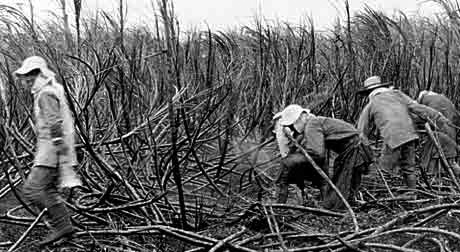
On May 21, 1945, the Hawaii Employee Relations Act, often referred to as the Little Wagner Act, was signed in Hawaii, guaranteeing the predominantly Native Hawaiian and Asian immigrant pineapple and sugar workers the right to bargain collectively. Union activity, which was gaining momentum in the late 1930s, was suspended during WWII. After negotiations failed, a successful 79-day strike shut down 33 of the territory’s 34 plantations and brought higher wages and a 40-hour week.
Oral History
“So, in a way, what I was thinking, our salvation in the plantation was that we could have a union. Because it was not a matter of wages and working conditions, but pride. . . . Because when you say you working for the plantation, you were pitied. That it was synonymous with one dollar a day and that you were living in one old plantation shack. So, union, to me, union is pride.” – Robert Kunimura (sugar plantation worker, county worker, union worker), University of Hawaii at Manoa, Center for Oral History.
The Big Five
In the Territory of Hawaii, Union membership only totaled about 500 in 1935 as a result of the economic control wielded by the Big Five, an oligarchy of sugarcane processing corporations. Attorney General of Hawaii Dole in 1903 said, “There is a government in this Territory which is centralized to an extent unknown in the United States, and probably almost as centralized as it was in France under Louis XIV.” (Hawaii was a U.S. territory for 60 years and was made a state August 21, 1959.)
The ILWU
But the International Longshoreman’s and Warehouseman’s Union (ILWU) had a long history in Hawaii:
By 1937, the National Labor Relations Act (NLRA) promoted collective bargaining and one year later these early unions affiliated with the West Coast ILWU as separate locals. Eventually workers formed four territory-wide locals: Local 136-Longshore and Allied Workers of Hawai’i, Local 142-United Sugar Workers, Local 150-Warehouse, Manufacturing & Allied Workers, and Local 152-Pineapple and Cannery Workers.
Eventually union membership grew to 10,000 but the establishment of martial law during World War II froze jobs and pay and union activity was curtailed by labor restrictions. Subsequently union membership declined to only 4,000 or less during the first years of the war although an estimated 25,000 to 35,000 temporary workers on O’ahu were members of mainland unions.
Under provisions of the 1945 Hawaii Employee Relations Act, representatives of the sugar industry and the ILWU signed the first agricultural labor contract ever negotiated in Hawai’i by free collective bargaining. The first ILWU agreement for sugar workers was signed by flashlight at night on top of a garbage can in the alley in back of the Waikiki Tropics.
It gave a seven-cents-an-hour increase in pay to 20,000 sugar workers who included Japanese laborers, provided for collective bargaining, and specified hours and working conditions.
By 1947, union leaders estimated that the majority of their 40,000 members belonged to the ILWU with other individuals belonging to the National Union of Maritime Cooks and Stewards, the American Communications Association, and the American Federal of Labor. While only twelve labor contracts existed in 1943, by 1947 there were 156 in existence in 116 separate business enterprises.
For a detailed account of workers’ struggles in Hawaii, read “Fighting Paradise: Labor Unions, Racism, and Communists in the Making of Modern Hawaii,” by Gerald Horne (Honolulu: University of Hawaii Press: 2011) 459 pp, reviewed here.
Photo: Sugar can cutters cutting sugar cane by hand at Makaweli Plantation, Kaua’i, ca. 1910. Kaua’I Historical Society archive photo by Ray Jerome Baker.










